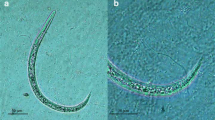Abstract
To evaluate the effect of temperature on the activity and mortality of the L3 of Angiostrongylus vasorum, 1,500 L3 were isolated from experimentally infected snails and distributed into five equal groups. Three groups were incubated at 37°C, 27°C, and 5°C. The remaining two groups were incubated at 27°C and 5°C for 10 days, at which time the temperature for the 27°C group was reduced to 5°C and the 5°C group increased to 27°C. Larva activity was observed daily and inactive larvae were removed. At 37°C, larvae survived up to 8 days. At 27°C, larvae were active until day 6. When subjected to a reduction in temperature from 27°C to 5°C beginning on day 10, the number of active larvae increased until day 13. Only on day 17 did the number of active larvae decline to zero. At 5°C, larvae remained active until day 15, surviving to 24 days. When temperature was increased from 5°C to 27°C beginning on day 10, larvae were found active until day 12 and maintained an intermediate level of activity to day 21. Survival of larvae was greater at lower temperatures, while high temperatures were associated with higher mortality.





Similar content being viewed by others
References
Baillet CC (1866) Strongle des vaisse au set du coeur du chein Strongylus vasorum (Nobis). N Dict Paract Med Vet 8:587–588
Barçante JMP, Barçante TA, Dias SRC, Vieira LQ, Lima WS, Negrão-Corrêa D (2003) A method to obtain axenic Angiostrongylus vasorum first-stage larvae from dog feces. Parasitol Res 89:89–93
Bolt G, Monrad J, Frandsen F, Henrikesen P, Dietz HH (1994) The common frog (Rana temporaria) as a potential paratenic and intermediate host for Angiostrongylus vasorum. Parasitol Res 79:428–430
Cabaret J, Risye Riseani S, Baeza E (1991) Survival of sheep and goat first stage protostrongylid larvae in experimental conditions: influence of humidity and temperature. J Helminthol 65:201–207
Dodd K (1973) Angiostrongylus vasorum (Baillet, 1866) infestation in a greyhound kennels. Rev Rec 92:195–197
Duarte FH, Vieira FM, Louzada GL, Bessa ECA, Souzalima S (2007) Ocurrence Angiostrongylus vasorum (Baillet, 1866) (Nematoda, Angiostrongylidae) in Cerdocyon thous Linnaeus, 1766 (Carnivora, Canidae) in Minas Gerais State Brazil. Arq Bras Med Vet Zootec 59:1086–1088
Ferdushy T, Kapel CMO, Webster P, Al-Sabi MNS, Gronvold JR (2010) The effect of temperature and host age on the infectivity and development of Angiostrongylus vasorum in the slug Arion lusitanicus. Parasitol Res 107:147–151
Grewal OS, Wang X, Taylor RAJ (2002) Dauer juvenile longevity and stress tolerance in natural populations of entomopathogenic nematodes: is there a relationship? Int J Parasitol 32:717–725
Grewal PS, Grewal SK, Tan L, Adams BJ (2003) Parasitism of molluscs by nematodes: types of associations and evolutionary trends. J Nematol 35:146–156
Guilhon J, Cens B (1973) Angiostrongylus vasorum (Baillet, 1866) Etude biologique et morfologique. Ann Parasitol 48:567–596
Jenkins EJ, Kutz SJ, Hoberg EP, Polley L (2006) Bionomics of larvae of Parelaphostrongylus odocoilei (Nematoda: Protostrongylidae) in experimentally infected gastropod intermediate hosts. J Parasitol 92:298–305
Kamensky SN (1905) Sistematich escoepolozhenieradov Metastrongylus wots in Protostrongylus g. n. sredidrugikh Strongylidae. Sbrnik Ttrudov Kkhard’kov Vet Insti 7:17–20
Lima W, Costa HMA, Guimarães MP, Leite ACR (1985) Angiostrongylus vasorum (Baillet, 1866) Nematoda: Prothostrongylidae em cães de Minas Gerais, Brasil. Mem Inst Oswaldo Cruz 80:233–235
Lima WS, Guimarães MP, Lemos IS (1994) Occurence of Angiostrongylus vasorum in the lungs of Brazilian fox Dusicyon vetulus. J Helminthol 68:87
Lorentzen G, Halvorsen O (1986) Survival of the first stage larva of the metastrongyloid nematode Elaphostrongylus rangiferi under various conditions of temperature and humidity. Holarct Ecol 9:301–304
Morera P (1985) Abdominal angiostrongyliasis: a problem of public health. Parasitol Today 1:173–175
Morgan ER, Shaw SE, Brennan SF, De Waal TD, Jones BR, Mulcahy G (2005) Angiostrongylus vasorum: a real heartbreaker. Trends Parasitol 21:49–51
Morgan ER, Jefferies R, Krajewski M, Ward P, Shaw SE (2009) Canine pulmonary angiostrongylosis: the influence of climate on parasite distribution. Parasitol Internat 58:406–410
Morgan ER, Jefferies R, Van Otterdijk L, Mc Eniry RB, Allen F, Bakewell M, Shaw SE (2010) Angiostrongylus vasorum infection in dogs: presentation and risk factors. Vet Parasitol 173:255–261
Morley NJ (2010) Aquatic molluscs as auxiliary hosts for terrestrial nematode parasites: implications for pathogen transmission in a changing climate. Parasitology 137:1041–1056
Patteson MW, Gibbs C, Wotton PR, Day MJ (1993) Angiostrongylus vasorum infection in seven dogs. Vet Rec 133:565–570
Richinitti LM, Fonseca NA, Graeff-Teixeira C (1999) The effect of temperature of mobility of Angiostrongylus costaricensis third stage larvae. Rev Inst Med Trop Sao Paulo 41:225–228
Rosen L, Ash LR, Wallace GD (1970) Life history of the canine lungworm Angiostrongylus vasorum (Baillet, 1866). Am J Vet Res 31:131–143
Shostak AW, Samuel WM (1984) Moisture and temperature effects on survival and inactivity of first-stage larvae of Parelaphostrongylus odocoilei and P. tenuis (Nematoda: Metastrongyloidea). J Parasitol 70:261–269
Skorping A (1982) Elaphostrongylus rangiferi: influence of temperature, substrate and larval age on the infection rate in the intermediate snail host, Aarianta arbustorum. Exp Parasitol 54:222–228
Thiengo SC (1996) Mode of infection of Sarasinula marginata (Mollusca) with larvae of Angiostrongylus costaricensis. Mem Inst Oswaldo Cruz 91:277–278
Thurston GS, Ni Y, Kaya HK (1994) Influence of salinity on survival and infectivity of entomopathogenic: nematodes. J Nematol 26:345–351
Weaver HJ, Hawdon JM, Hoberg EP (2010) Soil-transmitted helminthiases: implications of climate change and human behavior. Trends Parasitol 26:574–581
Williams JF, Lidermann B, Padget GA, Smith OL (1985) Angiostrongylus in a greyhound. J Am Vet Med Assoc 186:1101–1103
Author information
Authors and Affiliations
Corresponding author
Rights and permissions
About this article
Cite this article
Dias, S.R.C., dos Santos Lima, W. Effect of temperature on activity of third-stage larvae of Angiostrongylus vasorum . Parasitol Res 110, 1327–1330 (2012). https://doi.org/10.1007/s00436-011-2624-9
Received:
Accepted:
Published:
Issue Date:
DOI: https://doi.org/10.1007/s00436-011-2624-9




